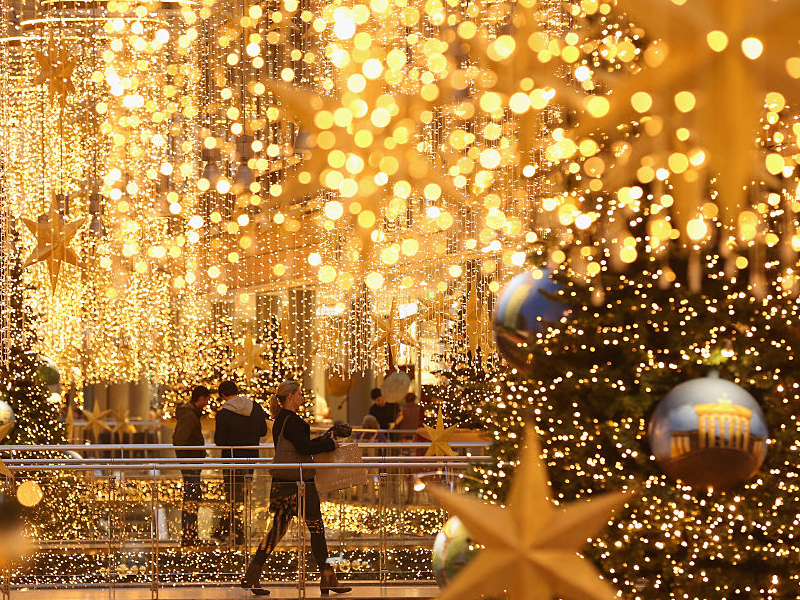- Every country and culture has it’s own holiday customs.
- Christmas, Hanukkah, Kwanzaa, New Year’s Eve, Halloween – you probably have a solid image in your mind of what each of these holidays look like. But that image all depends on where you come from and how you celebrated throughout your life.
- Festivities can vary drastically even within country borders.
- Some holidays like Day of the Dead have been around for centuries, and others like the celebration of Kwanzaa are relatively new.
- Here’s what some of these major holidays look like around the world.
- Visit Insider’s homepage for more stories.
Jewish people around the world start to celebrate Hanukkah on the 25th day of the month of Kislev — it usually falls around November or December on the Gregorian calendar.

The festival of lights commemorates the miracle of Hanukkah that is said to have kept a single vile of oil burning for eight days. People celebrate with latkes, games of dreidel, sufganiyot, and lighting the menorah — potato pancakes, spinning tops, jelly doughnuts, and the nine-candle candelabra.

If you visit Sweden, Norway, and Swedish-speaking parts of Finland on December 13 you’ll find yourself in the middle of St. Lucia’s Day celebrations — a festival combining pagan and Christian traditions into one holiday.

Source: Encyclopædia Britannica
This Scandinavian festival honors one of the earliest Christian martyrs, St. Lucia. There’s a procession of the town-elected, mock St. Lucia and young boys and girls dressed in white and singing traditional songs — the girls wear head wreaths featuring stars or candles.

Source: Encyclopædia Britannica
This festival of light is meant to brighten up the darkest time of the year while earmarking the start to the Christmas season. Observing families typically have their oldest daughter dress up in white and serve coffee, saffron bread, and ginger biscuits to family and guests.

Source: Encyclopædia Britannica
Rovaniemi, Finland, has been dubbed the “official hometown of Santa Claus.” Naturally, it’s always Christmas season there.

Source: Visit Rovaniemi
Locals and visitors can visit Santa 365 days a year, and children have been known to come from around the world to deliver their Christmas lists in person.

Source: Business Insider
Christmas in Croatia involves lots and lots of lanterns. During what has now become a pre-Christmas tradition in the capital city, participants send lanterns carrying their hopes and wishes into the Zagreb skies.

Similarly to Christmas Eve in other Eastern European countries, Badnjak — as it's called in Croatia — is typically celebrated with straw under the tablecloth and fish dishes instead of meat.

There is also the tying of the Christmas wheat, which has been sprouting since St. Lucia's Day — Croatians tie the plant together with red, white, and blue ribbon and place it under the Christmas tree for luck.

Source: TripSavvy
The Christmas Day meal usually features meat as the main dish and stuffed cabbage, poppy seed rolls, and fig cake as sides. Many Croatians visit the Dolac Market in Zagreb to do their preparatory shopping.

Christmas in Mexico often means it's time for pastorelas. This centuries-old tradition puts residents and actors on stage to recreate the biblical scene of shepherds following the Star of Bethlehem to find Christ.

Source: Business Insider
People all over Mexico put on slightly different versions of the pastorelas, but they all have a common theme: "Good always overcomes Evil."

Source: Inside Mexico
The New Year celebration in Belarus and across Russia is called Kolyada. The ancient pagan holiday involves different rituals that observers believe will bring a good harvest in the season to come.

Source: Russia Beyond and Belarus
They also celebrate Christmas with Father Frost — sometimes called Grandfather Frost — and his granddaughter, Snow Maiden. Father Frost is the gift-giving, bearded man in this part of the world.

Greeks celebrate Christmas with light-up ships. These symbolize the happiness felt throughout the country when residents were reunited with their relatives who had been out at sea for extended periods of time.

In some countries including America, Christmas has also become a largely commercial holiday. It's filled with loads of presents, decorations, parties, and ...

... did we mention the presents?

Some Americans begin to celebrate Christmas as soon as Thanksgiving is over. They'll bring a tree into their homes, send holiday cards, sing carols, and bring their children — or themselves — to the mall for a photo with Santa.

In the UK, Queen Elizabeth delivers her annual Christmas Day broadcast to the Commonwealth from Buckingham Palace. Her messages tend to reflect on current events and the meaning of Christmas.

Source: The British Royal Family
Religious observers in the states might attend Christmas Eve or Christmas Day mass at their local church.

Kwanzaa is a relatively new holiday created in America and celebrated every December 26.

Dr. Maulana Karenga, professor and chairman of Black Studies at California State University, Long Beach, started the holiday in 1966 following the Watts riots in Los Angeles. He wanted to find a way to revive and foster the African-American community.

Source: History
Dr. Karenga combined harvest celebrations from different African tribes, taking values and traditions from each, to lay the groundwork for Kwanzaa.

Source: History
Everyone celebrates Kwanzaa a little differently, but the principles and basis stay the same: Families celebrate for seven nights, lighting one candle on the Kinara each night before discussing one of the seven principles.

Source: History
People in Ecuador bring in the New Year with a sort of cleansing ritual.

Source: MSN
Some residents build, sell, or buy models of characters and political figures. Others write down their faults and attach them to a doll made out of straw and dressed in the writer's clothes.

Source: MSN
The models and mannequins are then burned on New Year's Eve, symbolically ridding everyone of their faults for the year ahead.

Source: MSN
Scotland celebrates the New Year similarly to other countries in the world — in some ways. There are typically fireworks lighting up the sky, Christmas markets with rides still open, people ringing bells, and some celebrators even jump into cold bodies of water.

Source: MSN
There's another time-honored practice, though, that involves bringing a gift over to a friend's home.

Tradition says out of all the visitors you get that night, if a man walks into your home first, you'll have good luck for the rest of the new year. However, if a woman is first to walk through your door, you're in for a year of bad luck.

Members of the worldwide Chinese community celebrate the Chinese New Year. The Lunar calendar usually puts this holiday around late January or early February.

Source: MSN
Stateside celebrations usually last a few days, but celebrations in China can last up to 13 days.

Source: MSN
The festivities are a religious combination of Confucian, Buddhist, and Taoist traditions.

Source: MSN
Traditionally people celebrate with foods like dumplings, colorful dragon dances, and fireworks.

Source: MSN
The Lunar New Year is known as the most important holiday in Chinese culture. To honor that, many buy new clothes and give children hongbao — red envelopes with money inside.

Source: MSN
In Brazil, the Cristo Redentor statue glows red to celebrate the Chinese New Year.

The New Year is also an important holiday in Japan. There, it's called Omisoka.

Traditionally observers will clean their homes, sit down for a feast, visit shrines and temples, and ring a bell at midnight — literally ringing in the new year.

Source: Patternz
The Great Cleaning is more than just cleaning out clutter from the past year. It's an ancient Shinto value and is believed to bring you luck in the year ahead. Observers will clean homes, shrines, and temples, and they'll take a cleansing bath at the end of the night known as Toshi no Yu — the year's bath.

Source: Patternz
The Epiphany — or Three Kings Day — is celebrated in Christian communities around the world on January 6.

Source: MSN
Children in Spain traditionally leave a box of hay under their beds or outside in hopes of getting a present.

Source: MSN
The Epiphany also signals the beginning of Carnival season. The French celebrate with King Cake — a typically fruity cake that has a toy, coin, jewel, or another trinket baked inside. If you get the piece with the object, observers believe you'll have luck all year-round.

Source: MSN
In Israel, the Jewish holiday, Purim, is the time to dress up. On the 14th day of the month of Adar, — usually falling in March on the Gregorian calendar— many Israelis celebrate at festivals like this one in Tel Aviv.

The holiday commemorates the biblical salvation story of the Jewish people from Prime Minister Haman in ancient Persia. It marks the day the Jewish people were granted the right to defend themselves against enemies.

Source: Chabad
Traditionally, the holiday is celebrated with the reading of the megillah — the scroll telling the story — giving money to people in need, and eating hamantaschen — a triangle, sweets-filled cookie.

Muslims around the world fast from sunrise to sunset for the entire ninth month of the Islamic calendar year, around May and June on the Gregorian calendar. They celebrate the end of Ramadan with the Eid-al-Fitr festival.

Source: Scholastic
While Hanukkah may be the most well-known Jewish holiday in the commercial world, the holiest of holidays for Jews around the globe at all levels of observance is Yom Kippur.

The Day of Atonement falls on the 10th day of Tishrei, which usually puts it around mid-September. On this day, observers traditionally fast and pray for 25 hours before breaking the fast with family and friends.

Source: Hebcal
Halloween is celebrated every year on October 31. It's believed to have originated from a Celtic festival called Samhain, during which time people would ward off ghosts with bonfires and costumes.

Source: History
It's now largely Westernized and commercialized with pop culture-inspired costumes, trick-or-treating, and jack-o'-lanterns. Visit any neighborhood in the US on October 31 and you'll find a handful of princesses and superheroes with a significant sugar rush.

But, since it's a Pagan holiday at its core, Halloween isn't as widely celebrated outside the US.

November 1 marks Día de los Muertos in Mexico. It often gets wrongly looped in with Halloween because of the death motif.

Day of the Dead — as it's also called — is two days of color, joy, love, respect, and celebrating family members who have died. Colorful calaveras and calacas — skulls and skeletons —are strung up and sold for the festivities.

Source: National Geographic
What began with Mexico's indigenous people, it is now celebrated all throughout the country by Mexicans of all backgrounds and religions. Ofrendas — altars — are set up to display photos of loved ones, welcoming their spirits back for the holiday.


